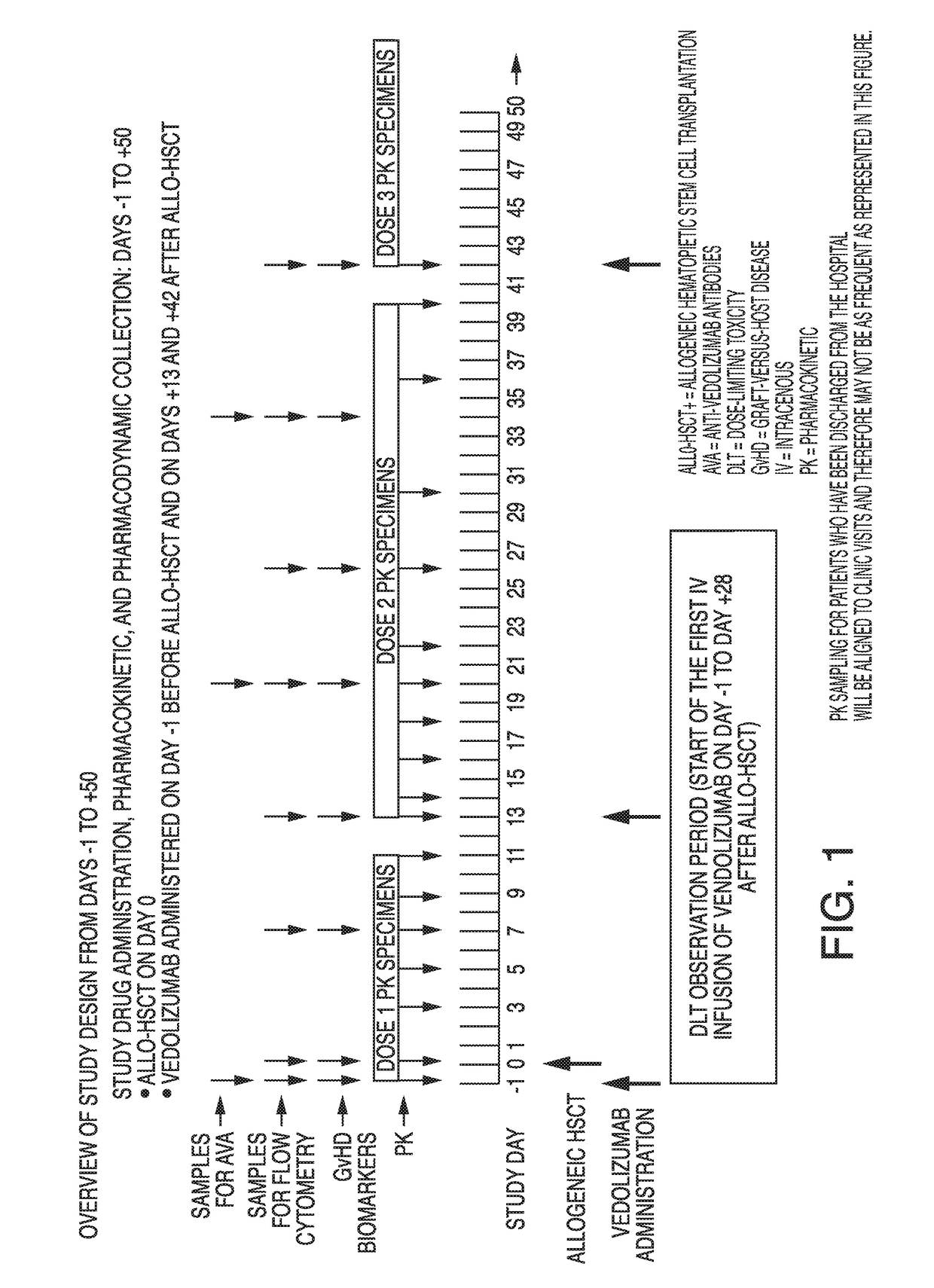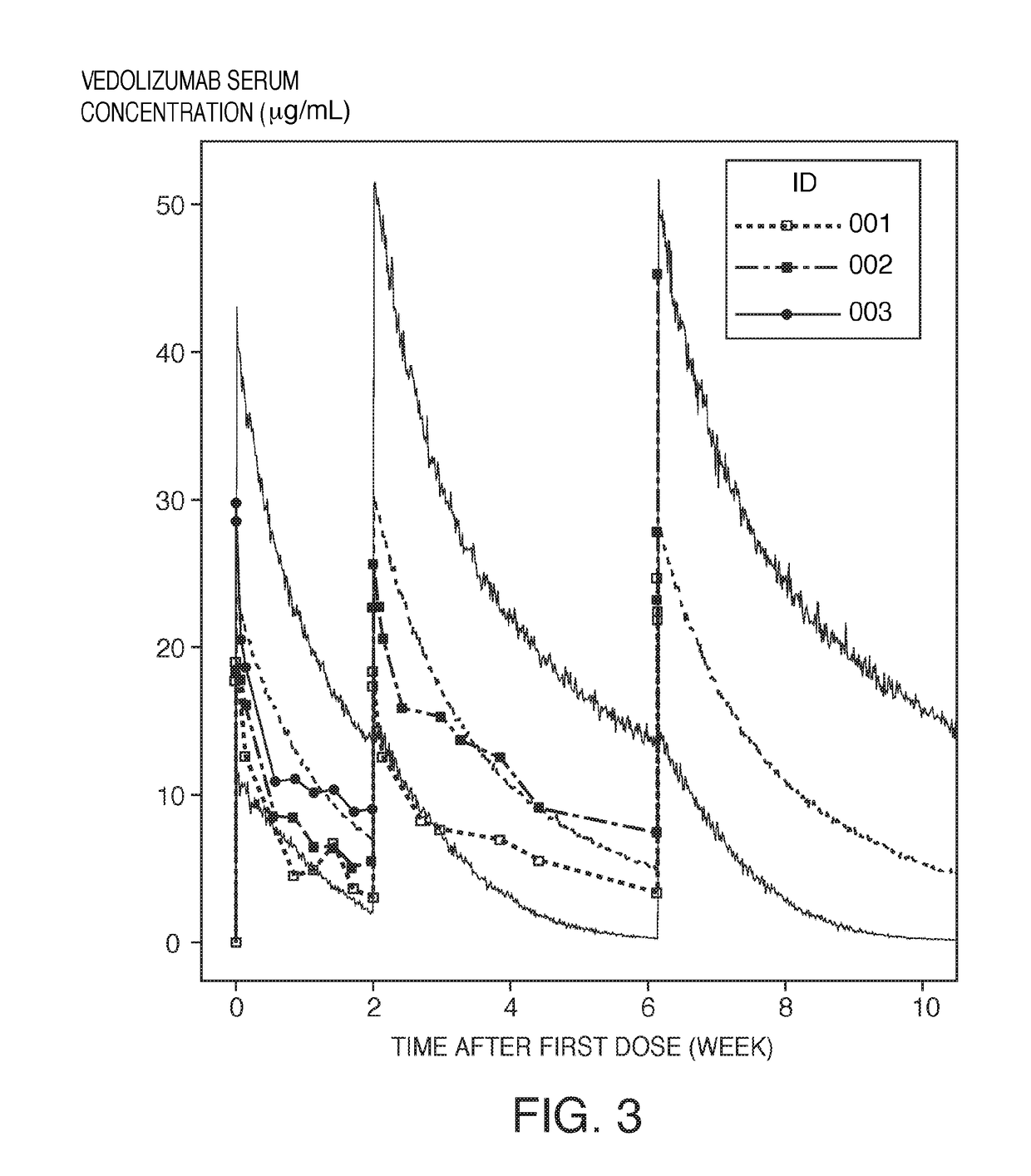Methods of treating or preventing graft versus host disease
a technology of host disease and graft, which is applied in the direction of antibody medical ingredients, drug compositions, immunological disorders, etc., can solve the problems of hsct being a major cause of morbidity and mortality, affecting the survival rate increasing the risk of adverse events of patients with acute gvhd, so as to reduce the occurrence of acute gvhd, reduce the cumulative incidence and severity, and reduce the occurrence of acu
- Summary
- Abstract
- Description
- Claims
- Application Information
AI Technical Summary
Benefits of technology
Problems solved by technology
Method used
Image
Examples
example 1
[0112]A phase 1b, open-label, dose-finding study is designed to evaluate the safety, tolerability, and clinical activity of adding vedolizumab to standard graft-versus-host disease (GvHD) prophylaxis (tacrolimus plus short-term methotrexate) in adult patients undergoing allogeneic hematopoietic stem cell transplantation (allo-HSCT). Vedolizumab dose finding is cohort based and follows a rule-based dose-finding study design with pharmacokinetic (PK) guidance. After a tolerated dose with acceptable PK is identified, the cohort at that dose level may be expanded to further assess the tolerability and effectiveness of vedolizumab.
[0113]Eligibility is determined during the Screening period, which may last for up to 28 days before Day −1 (designation of the day of the first IV infusion of vedolizumab). Patients who meet all eligibility criteria and provide written informed consent are enrolled in this study. Study drug is administered initially on Day −1 before allo-HSCT and then on Days ...
example 2
Treatment of Graft Versus Host Disease
[0122]An open-label phase 2a study is conducted to assess the tolerability and effectiveness of intravenously administered vedolizumab for the treatment of graft versus host disease in patients who have undergone allogeneic hematopoietic stem cell transplantation (allo-HSCT). The study will also be used to identify a recommended dose and regimen of intravenously administered vedolizumab for this indication. The study will enroll approximately 38 participants, who will be randomized at a ratio of 1:1 to 2 treatment arms to receive either 300 mg or 600 mg vedolizumab IV on Days 1, 15, 43, 71, and 99.
A. Description of Investigational Agent
[0123]The vedolizumab drug product is a sterile lyophilized solid formulation provided in a single vial, where each vial nominally contains 300 mg of vedolizumab antibody. Reconstituted vedolizumab IV drug product contains 60 mg / mL of active vedolizumab antibody, 50 mM histidine / histidine HCl, 125 mM arginine HCl,...
example 3
[0194]Monte Carlo simulations were run with a population pharmacokinetic model of vedolizumab serum concentration in clinical studies. Simulations included interindividual and residual variability in addition to weight and albumin effects. All other covariates were set to their reference values. One thousand adult patients were simulated in this study. Albumin and weight were randomly sampled from a normal distribution. The simulated dosing regimen was 75 mg of vedolizumab via a 30 minute IV infusion on days −1, +13, +42 (i.e., days 0, 14 and 43 relative to first dose).
[0195]Observed data from three patients enrolled in the phase 1b, open-label, dose-finding study (Example 1) was overlaid with the simulation data (see FIG. 3). The “fuzziness” of the region between the jagged lines is due to residual variability. FIG. 3 illustrates the measured and simulated vedolizumab serum concentration over time. In this figure, the vedolizumab concentration in one patient did not reach 10 μg / ml ...
PUM
| Property | Measurement | Unit |
|---|---|---|
| median time | aaaaa | aaaaa |
| concentrations | aaaaa | aaaaa |
| concentration | aaaaa | aaaaa |
Abstract
Description
Claims
Application Information
 Login to View More
Login to View More - R&D
- Intellectual Property
- Life Sciences
- Materials
- Tech Scout
- Unparalleled Data Quality
- Higher Quality Content
- 60% Fewer Hallucinations
Browse by: Latest US Patents, China's latest patents, Technical Efficacy Thesaurus, Application Domain, Technology Topic, Popular Technical Reports.
© 2025 PatSnap. All rights reserved.Legal|Privacy policy|Modern Slavery Act Transparency Statement|Sitemap|About US| Contact US: help@patsnap.com



